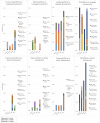Predictors and pathways of language and motor development in four prospective cohorts of young children in Ghana, Malawi, and Burkina Faso
- PMID: 28543426
- PMCID: PMC5697619
- DOI: 10.1111/jcpp.12751
Predictors and pathways of language and motor development in four prospective cohorts of young children in Ghana, Malawi, and Burkina Faso
Abstract
Background: Previous reviews have identified 44 risk factors for poor early child development (ECD) in low- and middle-income countries. Further understanding of their relative influence and pathways is needed to inform the design of interventions targeting ECD.
Methods: We conducted path analyses of factors associated with 18-month language and motor development in four prospective cohorts of children who participated in trials conducted as part of the International Lipid-Based Nutrient Supplements (iLiNS) Project in Ghana (n = 1,023), Malawi (n = 675 and 1,385), and Burkina Faso (n = 1,122). In two cohorts, women were enrolled during pregnancy. In two cohorts, infants were enrolled at 6 or 9 months. In multiple linear regression and structural equation models (SEM), we examined 22 out of 44 factors identified in previous reviews, plus 12 additional factors expected to be associated with ECD.
Results: Out of 42 indicators of the 34 factors examined, 6 were associated with 18-month language and/or motor development in 3 or 4 cohorts: child linear and ponderal growth, variety of play materials, activities with caregivers, dietary diversity, and child hemoglobin/iron status. Factors that were not associated with child development were indicators of maternal Hb/iron status, maternal illness and inflammation during pregnancy, maternal perceived stress and depression, exclusive breastfeeding during 6 months postpartum, and child diarrhea, fever, malaria, and acute respiratory infections. Associations between socioeconomic status and language development were consistently mediated to a greater extent by caregiving practices than by maternal or child biomedical conditions, while this pattern for motor development was not consistent across cohorts.
Conclusions: Key elements of interventions to ensure quality ECD are likely to be promotion of caregiver activities with children, a variety of play materials, and a diverse diet, and prevention of faltering in linear and ponderal growth and improvement in child hemoglobin/iron status.
Keywords: Language development; growth; iLiNS Project; lipid-based nutrient supplements; low- and middle-income countries; motor development; nutrition; risk factors; stimulation.
© 2017 The Authors. Journal of Child Psychology and Psychiatry published by John Wiley & Sons Ltd on behalf of Association for Child and Adolescent Mental Health.
Figures





References
-
- Aboud, F.E. , & Yousafzai, A.K. (2015). Global health and development in early childhood. Annual Review of Psychology, 66, 433–457. - PubMed
-
- Adu‐Afarwuah, S. , Lartey, A. , Okronipa, H. , Ashorn, P. , Zeilani, M. , Peerson, J.M. , … & Dewey, K.G. (2015). Lipid‐based nutrient supplement increases the birth size of infants of primiparous women in Ghana. American Journal of Clinical Nutrition, 101, 835–846. - PubMed
-
- Arimond, M. , Abbeddou, S. , Kumwenda, C. , Okronipa, H. , Hemsworth, J. , Jimenez, E.Y. , … & Dewey, K.G. (2016). Impact of small quantity lipid‐based nutrient supplements on infant and young child feeding practices at 18 months of age: Results from four randomized controlled trials in Africa. Maternal & Child Nutrition. Advanced online publication. https://doi.org/10.1111/mcn.12377. - DOI - PMC - PubMed
-
- Ashorn, P. , Alho, L. , Ashorn, U. , Cheung, Y.B. , Dewey, K.G. , Gondwe, A. , … & Maleta, K. (2015). Supplementation of maternal diets during pregnancy and for 6 months postpartum and infant diets thereafter with small‐quantity lipid‐based nutrient supplements does not promote child growth by 18 months of age in rural Malawi: A randomized controlled trial. Journal of Nutrition, 145, 1345–1353. - PubMed
MeSH terms
Substances
LinkOut - more resources
Full Text Sources
Other Literature Sources
Medical

